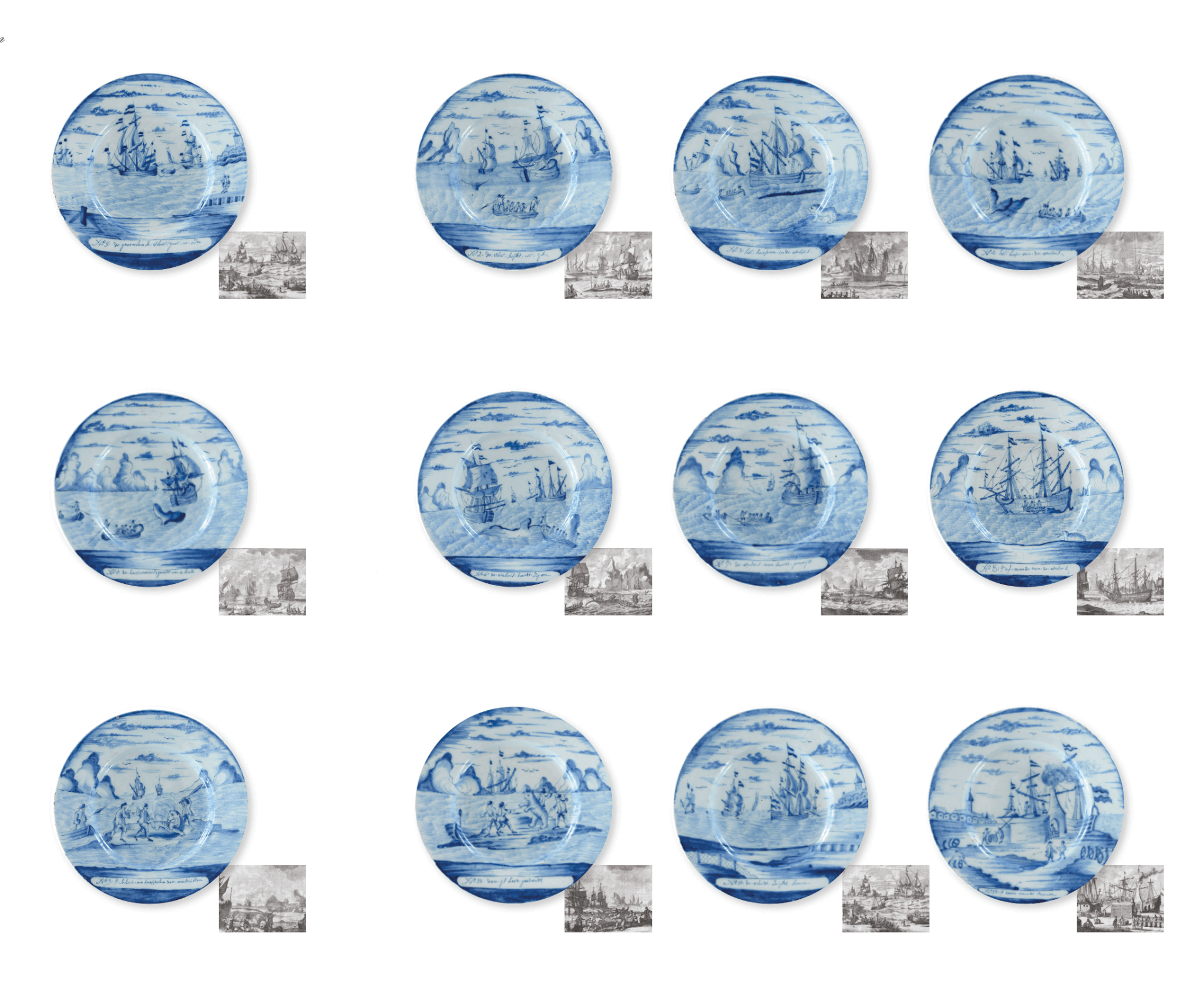
[popup_trigger id=”13756″ tag=”span”]![]() [/popup_trigger]
[/popup_trigger]
Images on this website are licensed under a
Creative Commons Attribution-NoDerivs 3.0 Unported License.
OBJECT
D2061. Set of Twelve Blue and White Whaling Plates
Delft, circa 1780
J:h:F / 1402 / in:t:Fortuijn marks in blue for Johannes Hermanus Frerking, shopkeeper of ‘t Fortuyn (The Fortune) factory, 1771- 1784
Each painted with a different scene of the whaling trade above a numbered label inscribed with the activity depicted:
No 1: de groenlanse : vloot : gaat : in : Zee
(The Greenland fleet sets out to sea)
No 2: de : vloot : Saiijldt : int : ijs
(The fleet sails into the ice)
No 3: het : harpoen : in de : walvis
(The harpoon in the whale)
No 4: het : loope : van : de : walvis
(The running of the whale)
No 5: de : harpoeniers : gereedt om : te lense
(The harpooners ready to lance)
No 6: de : walvis : keerdt : Zig : om
(The whale turns over)
No 7: de : walvis : naa : boordt : geroeiijdt
(The whale is rowed to the ship)
No 8: ‘t af : maake : van : de : walvis
(The flensing of the whale [stripping of blubber])
No 9: ‘t : Schiete : en kneppelen den : walrüssen
(The shooting and beating of the walruses)
No 10: den : ijs beer : gedoodt
(The ice bear killed)
No 11: de : vloodt: Zeiijldt : binne
(The fleet sails in)
No 12: ‘t kooke : van de traan
(The boiling of the train oil [whale oil])
Dimensions
Diameters: 22.9 to 23.3 cm. (9 to 9.2 in.)
Provenance
Aronson Antiquairs, Amsterdam;
Private Collection, Czech Republic
Note
Whale “fishing” took place from April to August in the Greenland seas. During the seventeenth century, whaling progressed from bay and coastal waters to the open sea, and finally to the arctic waters, as illustrated on these Delft plates (see the polar bear on plate 10), where the whales would swim along the ice floes in search of plankton. The Greenland ice fishery required stronger-hulled ships, the so-called ‘Groendlandvaarders,’ whereas in the Davis Strait lighter ships could hunt. All of the whaling
ships were characterized by a large horizontal beam across the width of the stern from which the harpoon boats were lowered for the harpooners to hunt and kill the whale.
While the catch from coastal or bay whaling could be processed promptly in cookeries on land in settlements such as Smeerenburg [‘Blubber Town’], near Spitsbergen, for whaling on the open seas, time, geography and distances were such that the whales had to be slaughtered alongside the ship. The meat and blubber were barreled aboard the ships, and after the return of the fleet to the Dutch harbor, they were reduced to oil.
The Great and Small Fishery
The series of twelve ‘Whale Fishery’ plates has a counterpart series of twelve ‘Herring Fishery’ plates. Both series are decorated after the print series of the “Groote Visserij” (“Great Fishery”) engraved by Adolf van der Laan (circa 1690-1742) from drawings by Sieuwert van der Meulen (before 1683-1730). During the first decade of the seventeenth century alone, the herring fleets are calculated to have comprised 770 ships. In contrast, during the heyday of whaling in the second half of the seventeenth century, only around 150 to 200 ships set out each year, and consequently, whale fishing is referred to as the “Kleine Visserij” (“Small Fishery”). Whaling expeditions to Greenland and Davis Strait were launched from Amsterdam, the Zaanstreek area, De Rijp and Harlingen, and the whaling haul fulfilled a different consumer need, the whale blubber supplying oil used mainly for lighting.
The Delft series of the “Great” and “Small Fisheries” were produced in the second half of the eighteenth century by De Porceleyne Byl (The Porcelain Axe) and ‘t Fortuyn (The Fortune) factories, which, among others, also produced series of plates with biblical themes as well as depictions of the months of the year, each series limited to a dozen plates. In comparing the present set of plates with the sixteen prints from the “Kleine Visserij” series, it is evident that only the main scenes were selected by the Delft painters and then rendered with a simplification of the background and the number of people depicted. Similarly, the descriptive captions were shortened to the allotted space on the plates, and some in the whaling series were even interchanged with those from other prints. All of the Delft series vary slightly from one another in the details of the scenes and the spellings of the captions.
Like both series of prints, which were reissued in various languages up to the nineteenth century, the two series of Delft plates enjoyed great popularity for many years. It is perhaps the popularity of the charming individual scenes that caused most of the original sets to have been dispersed over time, and attempts to reassemble them often have resulted in slightly mismatched sets. Original and complete series, therefore, are very rare.
Similar examples
Plates from the whaling series, all from De Porceleyne Byl factory are illustrated by Charleston and Lunsingh Scheurleer 1979, monochrome pl. 90 (plate No. 6); Boyazoglu and de Neuville 1980, p. 124-125, pls. 135-138 (plates Nos. 6, 3, 5 and 12) and p. 145, pl. 153 (plate No. 10); Fourest 1980, p. 126, pl. 121 (plates Nos. 6, 4, 2, 11 and 3); Helbig, Vol. I, p. 210, fi g. 155 (plate No. 7); Lunsingh Scheurleer 1984, p. 282, pl. 265 (plate No. 4); Morley-Fletcher and McIlroy 1984, p. 220, no. 12 (plate No. 4); Aronson 2019, pp. 146-147, no. 74; and the New Bedford Whaling Museum, New Bedford MA, (S.M. Frank [ed.], Delftware: Dutch and Flemish Faience in the Kendall Whaling Museum, Kendall Whaling Museum Monograph Series No. 8, Sharon, MA, 1993, pp. 7-10, nos. 41- 52, with references to more series).








